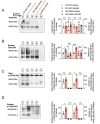This is a preprint.
Kappa Opioid Receptor Antagonism Restores Phosphorylation, Trafficking and Behavior induced by a Disease Associated Dopamine Transporter Variant
- PMID: 37205452
- PMCID: PMC10187322
- DOI: 10.1101/2023.05.03.539310
Kappa Opioid Receptor Antagonism Restores Phosphorylation, Trafficking and Behavior induced by a Disease Associated Dopamine Transporter Variant
Update in
-
Kappa opioid receptor antagonism restores phosphorylation, trafficking and behavior induced by a disease-associated dopamine transporter variant.Mol Psychiatry. 2025 May 29. doi: 10.1038/s41380-025-03055-4. Online ahead of print. Mol Psychiatry. 2025. PMID: 40442453
Abstract
Aberrant dopamine (DA) signaling is implicated in schizophrenia, bipolar disorder (BPD), autism spectrum disorder (ASD), substance use disorder, and attention-deficit/hyperactivity disorder (ADHD). Treatment of these disorders remains inadequate, as exemplified by the therapeutic use of d-amphetamine and methylphenidate for the treatment of ADHD, agents with high abuse liability. In search for an improved and non-addictive therapeutic approach for the treatment of DA-linked disorders, we utilized a preclinical mouse model expressing the human DA transporter (DAT) coding variant DAT Val559, previously identified in individuals with ADHD, ASD, or BPD. DAT Val559, like several other disease-associated variants of DAT, exhibits anomalous DA efflux (ADE) that can be blocked by d-amphetamine and methylphenidate. Kappa opioid receptors (KORs) are expressed by DA neurons and modulate DA release and clearance, suggesting that targeting KORs might also provide an alternative approach to normalizing DA-signaling disrupted by perturbed DAT function. Here we demonstrate that KOR stimulation leads to enhanced surface trafficking and phosphorylation of Thr53 in wildtype DAT, effects achieved constitutively by the Val559 mutant. Moreover, these effects can be rescued by KOR antagonism of DAT Val559 in ex vivo preparations. Importantly, KOR antagonism also corrected in vivo DA release as well as sex-dependent behavioral abnormalities observed in DAT Val559 mice. Given their low abuse liability, our studies with a construct valid model of human DA associated disorders reinforce considerations of KOR antagonism as a pharmacological strategy to treat DA associated brain disorders.
Conflict of interest statement
Conflicts of Interest All authors declare no conflicts of interest
Figures






Similar articles
-
Kappa opioid receptor antagonism restores phosphorylation, trafficking and behavior induced by a disease-associated dopamine transporter variant.Mol Psychiatry. 2025 May 29. doi: 10.1038/s41380-025-03055-4. Online ahead of print. Mol Psychiatry. 2025. PMID: 40442453
-
Region-Specific Regulation of Presynaptic Dopamine Homeostasis by D2 Autoreceptors Shapes the In Vivo Impact of the Neuropsychiatric Disease-Associated DAT Variant Val559.J Neurosci. 2018 Jun 6;38(23):5302-5312. doi: 10.1523/JNEUROSCI.0055-18.2018. Epub 2018 May 8. J Neurosci. 2018. PMID: 29739866 Free PMC article.
-
The rare DAT coding variant Val559 perturbs DA neuron function, changes behavior, and alters in vivo responses to psychostimulants.Proc Natl Acad Sci U S A. 2014 Nov 4;111(44):E4779-88. doi: 10.1073/pnas.1417294111. Epub 2014 Oct 20. Proc Natl Acad Sci U S A. 2014. PMID: 25331903 Free PMC article.
-
Leaky lessons learned: Efflux prone dopamine transporter variant reveals sex and circuit specific contributions of D2 receptor signalling to neuropsychiatric disease.Basic Clin Pharmacol Toxicol. 2024 Feb;134(2):206-218. doi: 10.1111/bcpt.13964. Epub 2023 Dec 6. Basic Clin Pharmacol Toxicol. 2024. PMID: 37987120 Review.
-
Genetic targeting of the amphetamine and methylphenidate-sensitive dopamine transporter: on the path to an animal model of attention-deficit hyperactivity disorder.Neurochem Int. 2014 Jul;73:56-70. doi: 10.1016/j.neuint.2013.11.009. Epub 2013 Dec 8. Neurochem Int. 2014. PMID: 24332984 Free PMC article. Review.
References
-
- Salamone JD. Complex motor and sensorimotor functions of striatal and accumbens dopamine: involvement in instrumental behavior processes. Vol. 107, Psychopharmacology. 1992. - PubMed
-
- Barnes JJM, Dean AJ, Nandam LS, O’Connell RG, Bellgrove MA. The molecular genetics of executive function: role of monoamine system genes. Biol Psychiatry. 2011. Jun 15;69(12):e127–43. - PubMed
-
- Volkow ND, Wang GJ, Kollins SH, Wigal TL, Newcorn JH, Telang F, et al. Evaluating Dopamine Reward Pathway in ADHD Clinical Implications [Internet]. 2009. Available from: https://jamanetwork.com/ - PMC - PubMed
Publication types
Grants and funding
LinkOut - more resources
Full Text Sources
